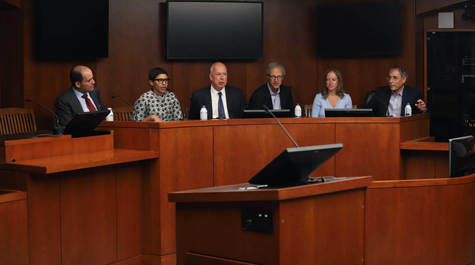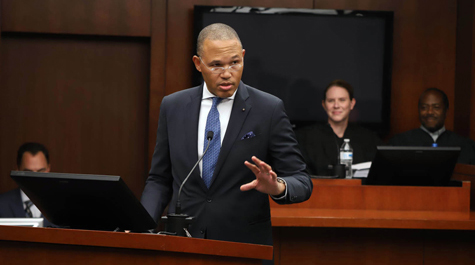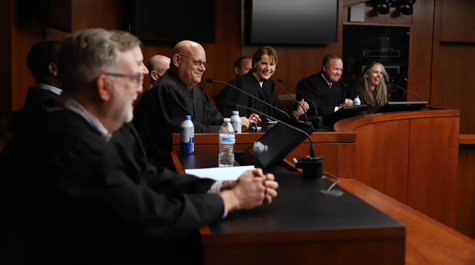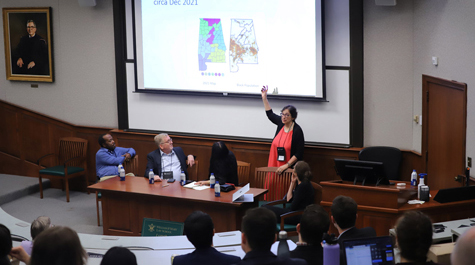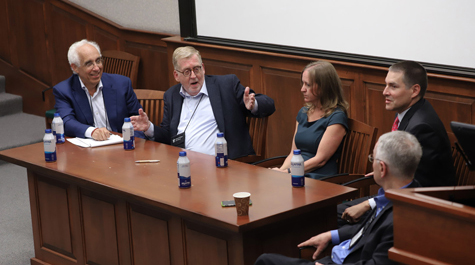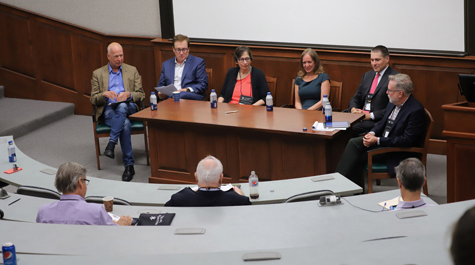William & Mary Law School Bring Experts Together for the 35th Annual Supreme Court Preview
Seismic.
That’s a word often used to describe the 2021-22 U.S. Supreme Court term. And the word was more than fitting for William & Mary Law School’s 35th Annual Supreme Court Preview, sponsored by the Law School’s Institute of Bill of Rights Law (IBRL). View gallery page.
This year’s Preview, held from September 16-17, featured prominent academics, four federal court of appeals judges, leading Supreme Court advocates who have collectively argued more than 500 cases before the Court, and Supreme Court reporters from the nation’s top newspapers.
Professor Allison Orr Larsen, who directs the IBRL, was thrilled with this year’s event.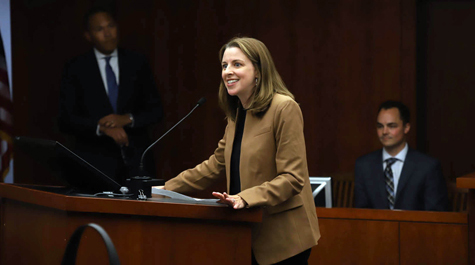
“The 2022 Preview was bigger than ever before—more panelists, more attendees, more blockbuster issues to discuss,” Larsen said. “It was tremendously exciting and, as always, a highlight of the year for many of us.”
The Preview officially began with its heralded Moot Court, this one considering Moore v. Harper (the independent state legislature case). The case arises from North Carolina’s efforts to draw new congressional maps in response to the 2020 census. Petitioners have invoked the “independent state legislature doctrine”—the idea that, under the U.S. Constitution, only the state legislature has the power to regulate federal elections, without interference from state courts.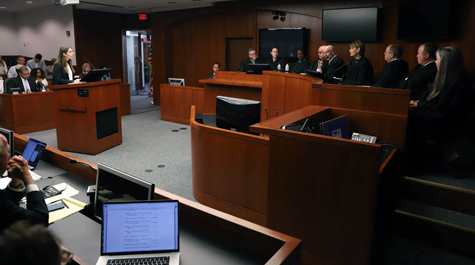
Advocates Luke McCloud (Williams & Connolly LLP) and Morgan Ratner (Sullivan & Cromwell LLP) argued the case in the academic exercise, one that of course does not necessarily reflect the views of the participants. The moot court judges—led by Joan Biskupic of CNN—peppered the advocates with questions and difficult hypotheticals.
“The advocacy at the Preview moot, as usual, was first-rate but it was particularly impressive this year because the briefing at the actual Supreme Court is not complete yet,” Larsen said. “Luke and Morgan had to be creative, and they rose to the challenge, demonstrating to our students and everyone in the room what true excellence in advocacy looks like.”
After the Moot Court, experts assembled to examine what comes next for the Roberts Court. The 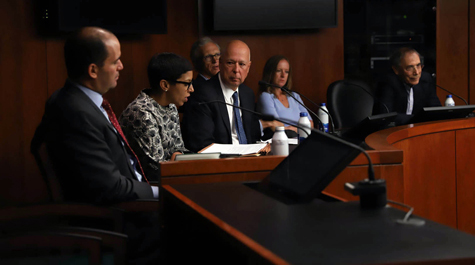 panel, moderated by Adam Liptak (New York Times), included Melissa Murray (NYU Law), Roman Martinez (Latham & Watkins LLP), Erin Murphy (Clement & Murphy PLLC), Jeff Fisher (Stanford Law) and Irv Gornstein (Supreme Court Institute, Georgetown Law Center). This all-star team of experts looked back at the dramatic Term that concluded in June and considered whether or not this is the beginning of a new era for the Court; they also weighed in how the fallout from the Dobbs leak or the 2022 midterm elections might affect the course of the Court’s decisions.
panel, moderated by Adam Liptak (New York Times), included Melissa Murray (NYU Law), Roman Martinez (Latham & Watkins LLP), Erin Murphy (Clement & Murphy PLLC), Jeff Fisher (Stanford Law) and Irv Gornstein (Supreme Court Institute, Georgetown Law Center). This all-star team of experts looked back at the dramatic Term that concluded in June and considered whether or not this is the beginning of a new era for the Court; they also weighed in how the fallout from the Dobbs leak or the 2022 midterm elections might affect the course of the Court’s decisions.
The Preview continued on Saturday, with a whirlwind round of panels considering thematic questions about the Court, and breakout “docket deep dive” sessions throughout the day.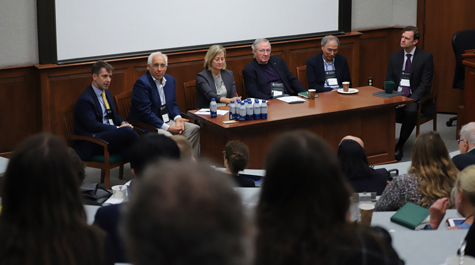
The main-session panels addressed the Supreme Court’s boldness in limiting the power of administrative agencies, predicted what will happen in the several cases the Court has already granted that explicitly consider race, considered the Court’s evolving doctrine on religious liberty, and explored new issues likely to face the Court in the wake of the big abortion and guns cases from the prior term.
Also included was a special panel entitled “Judging Hard Cases” in which moderator Neal Devins (W&M Law) asked questions of distinguished federal appellate judges: Judge Pam Harris (U.S. Court of Appeals, 4th Circuit), Judge Stephanos Bibas (U.S. Court of Appeals, 3rd Circuit), Judge Kevin Newsom (U.S. Court of Appeals, 11th Circuit) and Judge Toby Heytens (U.S. Court of Appeals, 4th Circuit). In a special treat, these judges went behind the scenes of the federal bench in a conversation that addressed the variables that make for the most challenging cases they hear.
Enhancing the fast-paced Preview were a number of IBRL-sponsored events around the Preview intended both to inform the general audience and provide invaluable points of contact between law students and the visiting experts.
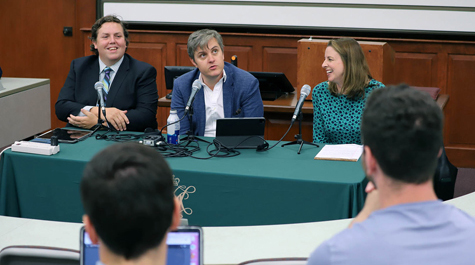 On Thursday, September 15, Professors Will Baude (University of Chicago) and Dan Epps (Washington University at St. Louis) recorded an episode of their podcast "Divided Argument" in front of a live, student audience, with special guest Professor Allison Orr Larsen appearing in a segment.
On Thursday, September 15, Professors Will Baude (University of Chicago) and Dan Epps (Washington University at St. Louis) recorded an episode of their podcast "Divided Argument" in front of a live, student audience, with special guest Professor Allison Orr Larsen appearing in a segment.
The event doubled as the second installment of the Scalia-Ginsburg Collegiality Speaker Series, which focuses on collegiality and friendship in the legal field during fraught times—a topic that Epps and Baude are quite familiar with as they host a popular podcast about the law, but hold different views about it (as the name “Divided Argument” suggests).
William & Mary and the IBRL also hosted the Law School’s annual Constitution Day Lecture in  commemoration of the September 17, 1787 signing of the U.S. Constitution. Professor Erwin Chemerinsky, Dean and the Jesse H. Choper Distinguished Professor of Law at Berkeley Law, delivered the lecture on September 16 to a packed room of students and faculty. The event also served as the annual Cutler Lecture in the Cutler Lecture series, which was established in 1927 by James Goold Cutler of Rochester, NY, to provide an annual lecture at William & Mary by "an outstanding authority on the Constitution of the United States."
commemoration of the September 17, 1787 signing of the U.S. Constitution. Professor Erwin Chemerinsky, Dean and the Jesse H. Choper Distinguished Professor of Law at Berkeley Law, delivered the lecture on September 16 to a packed room of students and faculty. The event also served as the annual Cutler Lecture in the Cutler Lecture series, which was established in 1927 by James Goold Cutler of Rochester, NY, to provide an annual lecture at William & Mary by "an outstanding authority on the Constitution of the United States."
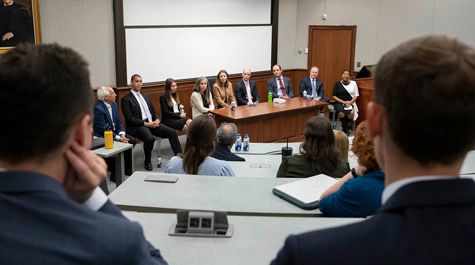 In addition to learning from the experts during the moot court and panel discussions, law students were able to register for a "Greenroom with Students," where available Supreme Court panelists were on hand to talk about their lives in the law and to give advice.
In addition to learning from the experts during the moot court and panel discussions, law students were able to register for a "Greenroom with Students," where available Supreme Court panelists were on hand to talk about their lives in the law and to give advice.
Students also hosted their own podcast during the Preview weekend, interviewing other students about their takeaways from the event.
“For me, hearing from an incredible panel about how the gun rights and abortion debates will likely play out over the next few years and getting to ask the lawyers involved in these battles about their tactics and goals, was a uniquely valuable experience,” said Tim Intelisano ’23. “Opportunities like that are why I chose to attend William & Mary in the first place!”
The 35th Supreme Court Preview was streamed live and will eventually be made available on William & Mary Law School’s You Tube channel.
Visit our gallery page for more about the 2022 Supreme Court Preview.
About William & Mary Law School
Thomas Jefferson founded William & Mary Law School in 1779 to train leaders for the new nation. Now in its third century, America’s first law school continues its historic mission of educating citizen lawyers who are prepared both to lead and to serve. citizen lawyers who are prepared both to lead and to serve.
